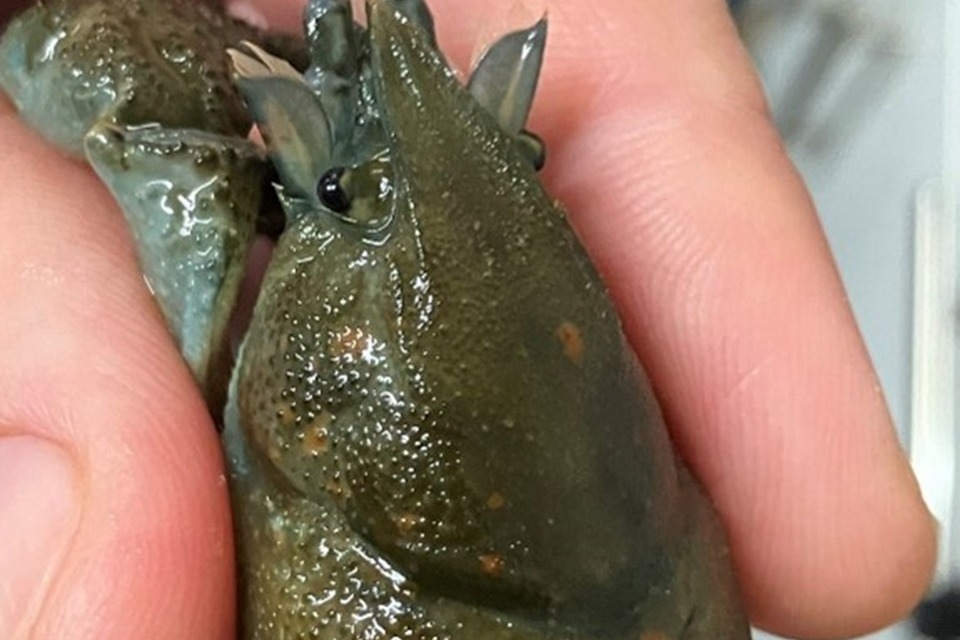The Environment Agency is working with partners to secure the future of the internationally important population in the River Wansbeck.
At the end of September, it was discovered that around 70 of the endangered native species had been found dead in the River Wansbeck catchment, one of the last remaining strongholds of the species.
It has since been established through extensive surveys that native crayfish displaying similar symptoms - unusual orange patches on their shell - are widespread across the Wansbeck catchment.
Crayfish displaying similar symptoms have also been discovered in the rivers South Tyne and Rede, which are in the neighbouring River Tyne catchment, and the River Pont, which is in the River Blyth catchment.
Over the coming days the Environment Agency will remove visibly healthy native crayfish from the River Wansbeck at the National Trust's Wallington Estate and from Northumbrian Water's Hallington Reservoirs, which are near Matfen and in the Tyne catchment.
Females carrying eggs - known as 'berried' females - will be kept in tanks at Northumberland Zoo, which has the facilities to rear the young and release them in the future.
Males and females will also be quarantined by the National Trust in tanks at Wallington. They will be monitored for a minimum of three months to ensure they do not develop symptoms before being released into safe 'ark' sites in the future.
Combined with work already carried out by the Northumberland Crayfish Partnership, this will help to safeguard the future of the population.

Image shows a native white clawed crayfish displaying symptoms.
Still 'a lot we don't know' about situation
Sarah Jennings, Area Environment Manager for the Environment Agency in the North East, said:
There's a lot we still don't know about what is happening to the white clawed crayfish in the area and our enquiries will continue.
But what we can do now is build on work that has already taken place through the Northumberland Crayfish Partnership to protect the future of this species.
With the support of our partners we will carry out rescues to move some crayfish into quarantine so they can be monitored, and if healthy, released back into the wild in future.
This is a positive step in what is still a concerning and developing situation.
Wallington National Trust Ranger, Nick Allen added:
Here at Wallington we are focused on playing our part in the rescue mission alongside other organisations from the Northumberland Crayfish Partnership.
This latest challenge to one of our country's native species is a stark reminder of the increasing number of threats nature is facing.
By working alongside partners to rescue a population from the Wansbeck and monitor them in the coming months at our quarantine facility, we're hopeful that our efforts will support the long-term survival of this species in Northumberland.
Latest update:
- The symptoms seen in crayfish includes unusual orange patches on their upper shell and in some cases opaque-white muscles in the tail.
- This is something the Environment Agency's field survey work has discovered in crayfish widespread across the River Wansbeck catchment, as well as in some areas of the neighbouring River Tyne catchment and on the River Pont in the River Blyth catchment.
- The total number of confirmed mortalities so far is around 100, with deaths still being reported. The Environment Agency is working to understand more about mortality rates and the long-term impact on the species. The vast majority of deaths so far have been in the Wansbeck catchment.
- The Environment Agency is carrying out monitoring of 30 affected native crayfish from the Hart Burn in tanks in its own lab at Tyneside House to understand more about how the symptoms develop as well as mortality rates.
- Testing carried out by the Centre for Environment, Fisheries and Aquaculture Science (Cefas) on crayfish returned negative results for the listed disease white spot syndrome virus, in addition to Bunya-like brown spot virus, crayfish plague, and no evidence for any significant bacterial infection was identified. There is no evidence for the presence of an emerging infectious disease agent in the samples analysed to date.
- Porcelain disease, caused by the microsporidian parasite Astathelohania contejeani, is known to infect and cause mortalities in freshwater crayfish and has previously been identified in crayfish around the country. This was present in some samples and is the only potentially relevant finding identified that could explain some of the mortalities observed.
- However, many affected crayfish are not showing any signs of porcelain disease, suggesting there is a wider issue which is not yet fully understood. The Environment Agency is continuing to work with Cefas. *Water quality testing carried out by the Environment Agency has ruled out pollution.
Public urged to follow advice
The public and especially river users are being urged to follow Check, Clean, Dry advice to prevent the spread of symptoms:
- Check clothing and equipment for mud, aquatic animals or plant material. Remove anything found and leave it at the site.
- Clean everything thoroughly as soon as possible, paying attention to areas that are damp or hard to access and using hot water if possible.
- Dry everything for as long as possible before using elsewhere.
Over the past five years since its launch, the Northumberland Crayfish Partnership, which includes the Environment Agency, Northumberland Rivers Trust, Northumberland Wildlife Trust, Northumberland Zoo and the National Trust, has already done a significant amount of work to safeguard the future of the native species.
This includes creating secure breeding areas and safe 'ark sites' across Northumberland to support conservation efforts and ensure the crayfish survives into the future.
Just this summer, in a first for the River Tyne catchment, two new 'ark sites' were created on the South Tyne near Haltwhistle by Tyne Rivers Trust and the Environment Agency. These sites will now be key to supporting the future of the species.






